HIGHLIGHTS: SEPTEMBER 20, 2024
• Colombia implements preliminary milk powder tariffs
• U.S. scores a Codex win on GIs
• U.S. dairy ingredient workshops held in Colombia, Guatemala
• Advancing dairy partnership in Indonesia
• Letter calls for GSP renewal
• USDEC at U.S.-China Business Council meeting
• Member benefit: new and improved cheese database
• USDEC on guard for EU GI activity at FAO
• Danish ag delegation visits USDEC offices
• U.S. cheese at Congressional Ag Trade Caucus
• USDEC calls on administration to help avert East, Gulf Coast port strike
• Market Summary: GDT rises 0.8%
• EU milk production growth weakens
• Changes to USDEC board elections
• Valio to upgrade powder capacity
• Lactalis invests in Brazil
• FoodWaikato makes colostrum investment
• Company briefs: Nestlé, Hiland, Fonterra, Danone
Featured
Colombia implements preliminary tariffs in CVD case; USDEC urges U.S. government response
On Tuesday, the Colombian government issued a preliminary ruling in its Subsidies and Countervailing Measures (CVD) investigation into U.S. milk powder exports. An additional tariff of 4.86% will apply to U.S. milk powder exports of HTS codes 0402.10.10.00, 0402.10.90.00, 0402.21.11.00, 0402.21.19.00, 0402.21.91.00, 0402.21.99.00, 0402.29.11.00, 0402.29.19.00, 0402.29.91.00, and 0402.29.99.00. The preliminary tariffs will be in effect for four months as the CVD case moves forward, starting from Sept. 17.
The provisional countervailing duties will not apply to imports that are already shipped to Colombia if the transportation document date is prior to Sept. 18. Duties are also not applied to imports that are in the primary customs zone or free trade zone, provided they are submitted under the ordinary importation modality and enter Colombia by Oct. 16 (20 Colombian business days from Sept. 17).
“It’s extremely unfortunate that the Colombian government has chosen to use these politically motivated allegations to impose protectionist trade barriers, which will ultimately not only harm U.S. exporters, but Colombian companies and workers who rely on U.S. dairy products and ingredients,” said Krysta Harden, USDEC president and CEO, in a USDEC-NMPF press release on the decision. “The U.S. government must act promptly and forcefully to send a message that these sorts of tactics will not be tolerated.”
Effort to halt tariffs continues
Since Colombia first announced the CVD case on July 5, USDEC has worked nonstop with allies in Colombia, USDEC members and the U.S. government to prove that no U.S. milk powder going to Colombia is subsidized and that Colombia’s dairy sector challenges are due to a variety of other factors. USDEC will continue to engage with allies and members as the investigation moves forward.
Actions to date include:
- In August, USDEC and member companies answered Colombia’s CVD questionnaire, strongly refuting allegations that U.S. dairy exports are being unduly subsidized and causing harm to the domestic Colombian dairy industry (see Global Dairy eBrief, 8/30/24).
- USDEC supported a letter from the bipartisan House Agricultural Trade Caucus to the Colombian Ambassador to the United States encouraging a mutually beneficial conclusion to the investigation.
- USDEC and NMPF sent a joint letter to USDA Secretary Tom Vilsack and USTR Katherine Tai urging them to be prepared to respond forcefully to counter any unwarranted tariffs that might result from the CVD investigation.
Next steps include the collection of further evidence by the Colombian government and an Oct. 3 public hearing to consider arguments in the case. USDEC and NMPF will participate in the hearing and continue to engage the U.S. government to respond forcefully to the unfounded tariffs.
Members who have questions about the Colombian ruling or USDEC’s response should contact Jaime Castaneda at jcastaneda@usdec.org.
USDEC-led effort yields victory against EU attempts to extend GIs into Codex food fraud guidelines
U.S. dairy suppliers—and other exporters and cheesemakers outside of the EU—scored a victory against attempts to further restrict the use of common food and beverage names at this week’s Codex Committee on Food Import and Export Inspection and Certification Systems (CCFICS). The EU has been leading an effort to write geographical indications (GIs) and intellectual property (IP) into the scope of Codex draft guidelines on the Prevention and Control of Food Fraud. If successful, the EU would have been able to lend Codex legitimacy to its efforts to brand non-European cheeses with common names like “feta” and “parmesan” as fraudulent.
USDEC Senior Vice President Nick Gardner traveled to Cairns, Australia, for the Sept. 16-20 CCFICS meeting. Gardner, on behalf of USDEC and working with USDEC’s Trade Policy team, led extensive outreach ahead of the session via the Pan American Dairy Federation (FEPALE) and the International Dairy Federation (IDF), worked closely with the U.S. government while in Australia, and spoke on behalf of the global dairy sector in opposition to including GIs in the scope of the guidelines. These collective efforts resulted in the Committee agreeing to explicitly state in the “scope” section of the guidelines that issues of IP are outside the document’s purview and conclude in the report of the meeting that GIs are included in the IP exclusion.
The Committee advanced the food fraud guidelines to step 5 in the Codex process, which protects the language on the scope. Other key parts of the guidelines, including definitions, are still under discussion and will be addressed at the next CCFICS meeting in two years. USDEC plans to remain engaged and push for definitions that limit further efforts by the EU to twist the food fraud guidelines to fit its GI scheme.
In addition to the food fraud discussion, the meeting also sought to advance work on the consolidated draft Codex guidelines related to equivalence and the draft revision and updating of the Principles for Traceability/Product Tracing as a Tool Within a Food Inspection and Certification System (CXG 60-2006). Intense discussions took place on both topics, and although the Committee incorporated edits on both documents, the drafts made limited overall progress.
Latin American food professionals, students trained at U.S. dairy ingredient workshops in Colombia and Guatemala
USDEC’s popular ingredients workshop series in Latin America continued in August and September with two training sessions in Colombia and three in Guatemala. The workshops combine classroom and hands-on instruction, guiding attendees on the functionality, versatility, application potential and overall benefits of using U.S. dairy ingredients in products popular in each respective region. The program started in Mexico in late 2020 and has since expanded to Brazil, Colombia, the Dominican Republic and now Guatemala.
Bogota, Colombia, Aug. 26 and Sept. 9
USDEC organized and hosted the Colombia workshops in collaboration with Universidad CES, a private technical university based in Medellin. Professor John Jairo Ortiz from the Universidad de Antioquia led the training, which focused on the benefits of using U.S. nonfat dry milk and MPC in yogurt and campesino cheese (a lightly pressed, fresh, salty cheese often used as a topping).
Jairo Ortiz led the classes through the manufacturing process for both products. Thirty-two food and dairy company representatives and students from the university participated, including representatives from major Colombian food processors Productos La Carreta, La Bugueña, and Industrias J Montes.
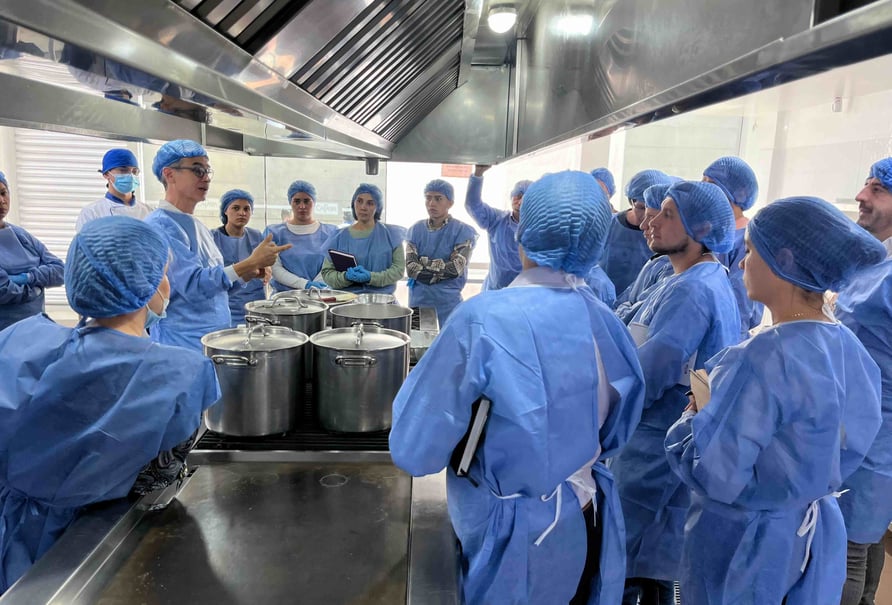
Professor John Jairo Ortiz (left, glasses) heats milk for yogurt making as he outlines the functionality benefits of U.S. dairy ingredient.
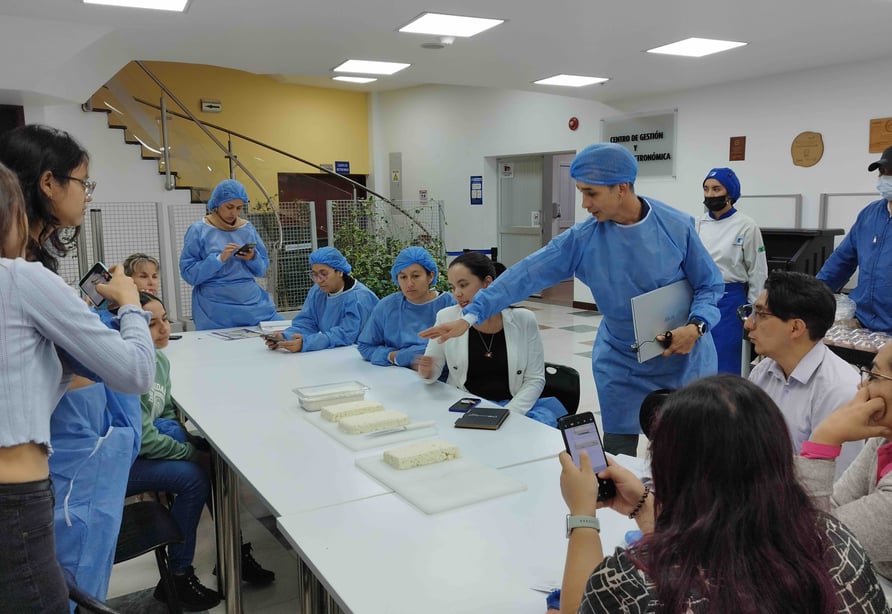
Jairo Ortiz explains how U.S. dairy ingredients affect the finished campesino cheese made during the hands-on portion of the workshop.
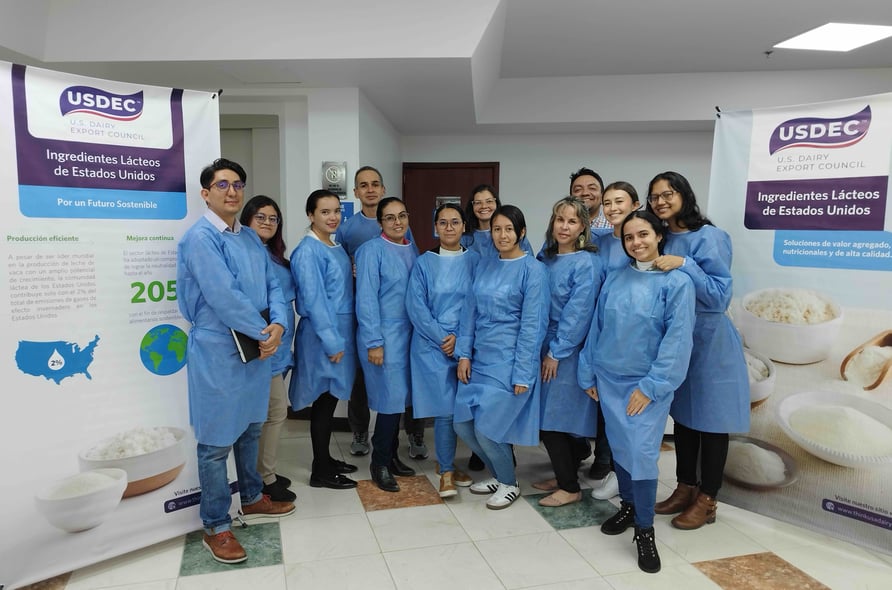
Students from Colombia’s Universidad CES and instructor John Jairo Ortiz (back, left).
Guatemala City, Sept. 10, 11 and 12
USDEC conducted the first ever U.S. dairy ingredients workshops in Guatemala with three dates in Guatemala City. The sessions attracted a total of 54 attendees, including food industry professionals, students and academia.
The USDEC Mexico/Central America team worked together with Guatemalan industry association Gremial de Lácteos y Derivados and the Universidad del Valle de Guatemala to organize and conduct the event. The classes focused on the benefits of using U.S. nonfat dry milk and MPC in Guatemalan fresh cheeses. Recognized industry expert Valesca Faillace served as the lead trainer, and several staff from the Guatemala City USDA Foreign Agricultural Service post also participated.
Interest in the training far exceeded capacity. USDEC has already scheduled two additional classes on Oct. 7 and 9 to meet demand. In addition, the Mexico/Central America office is working with the industry group the Association for Dairy Development (ASODEL) to target larger-scale dairy and food manufacturers.
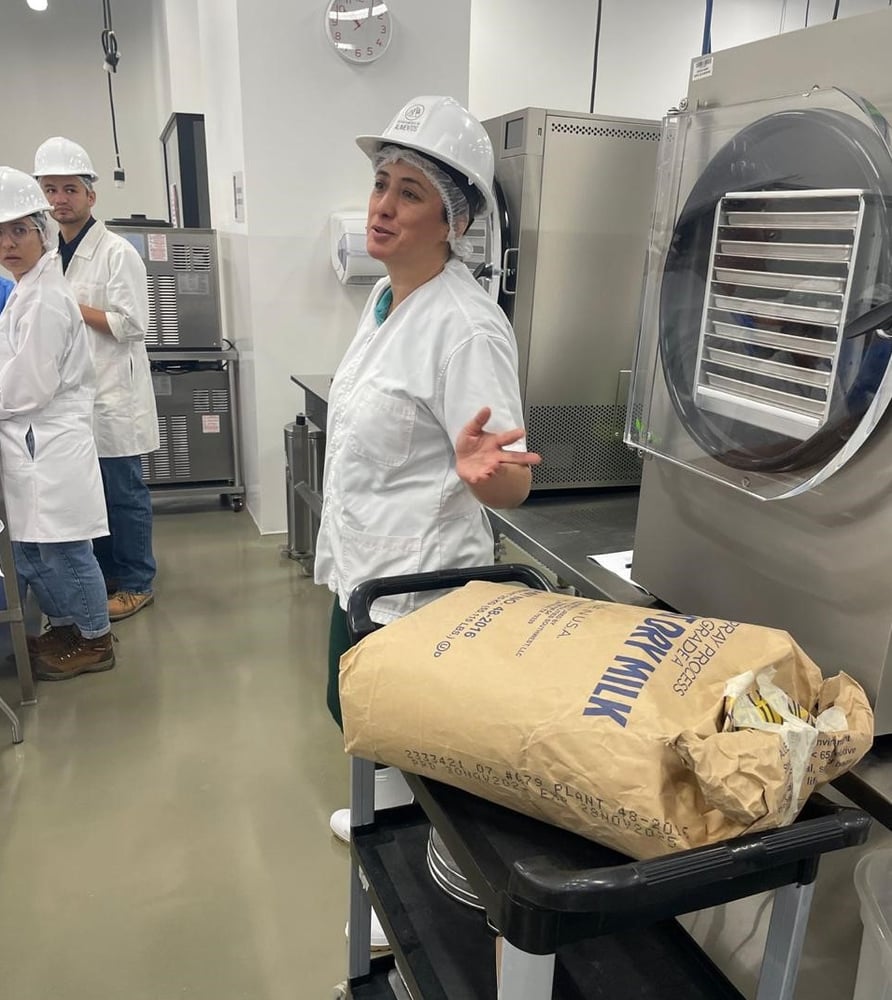
Valesca Faillace, lead trainer for the Guatemala workshops, explains how to incorporate U.S. nonfat dry milk when manufacturing Guatemalan fresh cheeses.
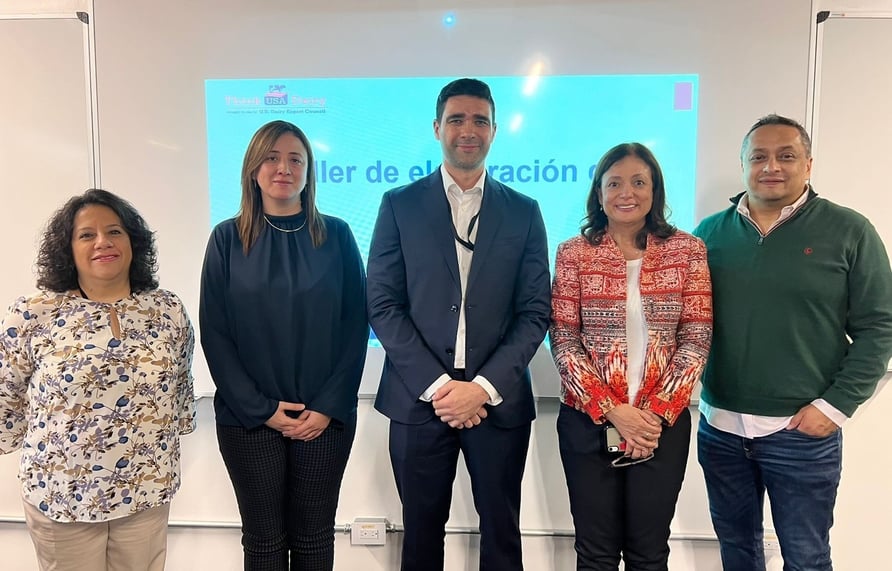
Left to right: Edith Vasquez, FAS; Valesca Faillace, workshop trainer; Jason Wrobel, FAS; Ana Silvia Colmenares, director of the Major in Food Technology for the Universidad del Valle de Guatemala (and a strong supporter of the workshop series); and Edgar Garcia, business development manager at the USDEC Mexico/Central America office.
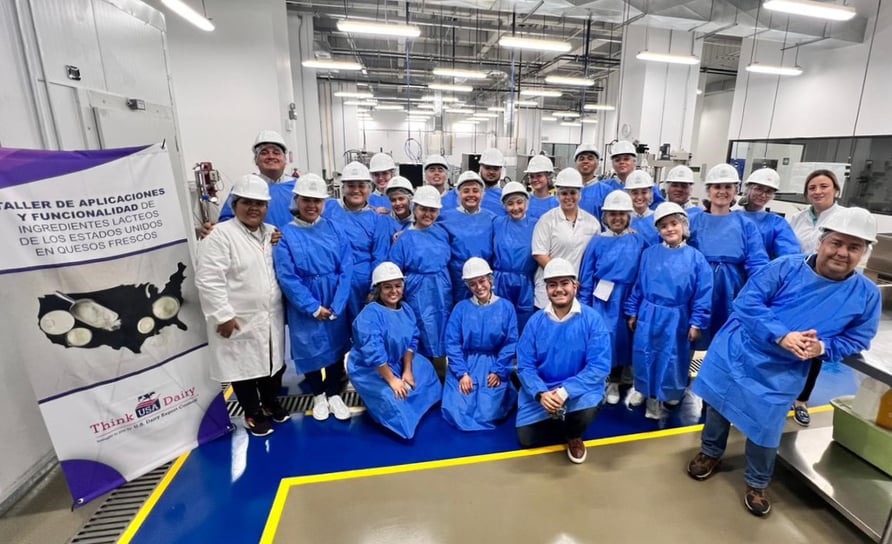
One class of attendees from this month’s U.S. dairy ingredient training at the Universidad del Valle de Guatemala in Guatemala City.
USDEC advances U.S. dairy partnership with Indonesia
Jonathan Gardner, USDEC senior vice president, Market Access and Regulatory Affairs (MARA), was in Jakarta this week for a series of meetings with Indonesian government officials and industry key opinion leaders to strengthen U.S.-Indonesian partnership ties following the last successful trip in June.
The meetings included a conference with Dr. drh. Agung Suganda, M.Si, the new director-general of the Directorate General of Livestock and Animal Health Services (DGLAHS) of the Ministry of Agriculture, where the dairy plant listing process and the dairy farm technical education program were discussed.
The dairy technical education program, which is a collaboration between USDEC and New Mexico State University (NMSU), aims to provide educational outreach to Indonesia’s small-scale farmers by partnering with leading academics and dairy cooperatives. The detailed curriculum for Indonesian farmers is adapted from U.S. materials to fit local needs and includes video instruction.
This week, Dr. Robert Hagervoort, associate professor and extension dairy specialist in the Extension Animal Sciences and Natural Resources Department of the College of Agricultural in the College of Consumer and Environmental Sciences at NMSU, and Brent Peterson with Antigravity Films, travelled to Malang in East Java. Together with USDEC local staff and a local dairy expert Dr. Deddy Kurniawan, they began filming footage of various aspects of local dairy farming. The footage is part of the curriculum content to demonstrate best practices in dairy farming.
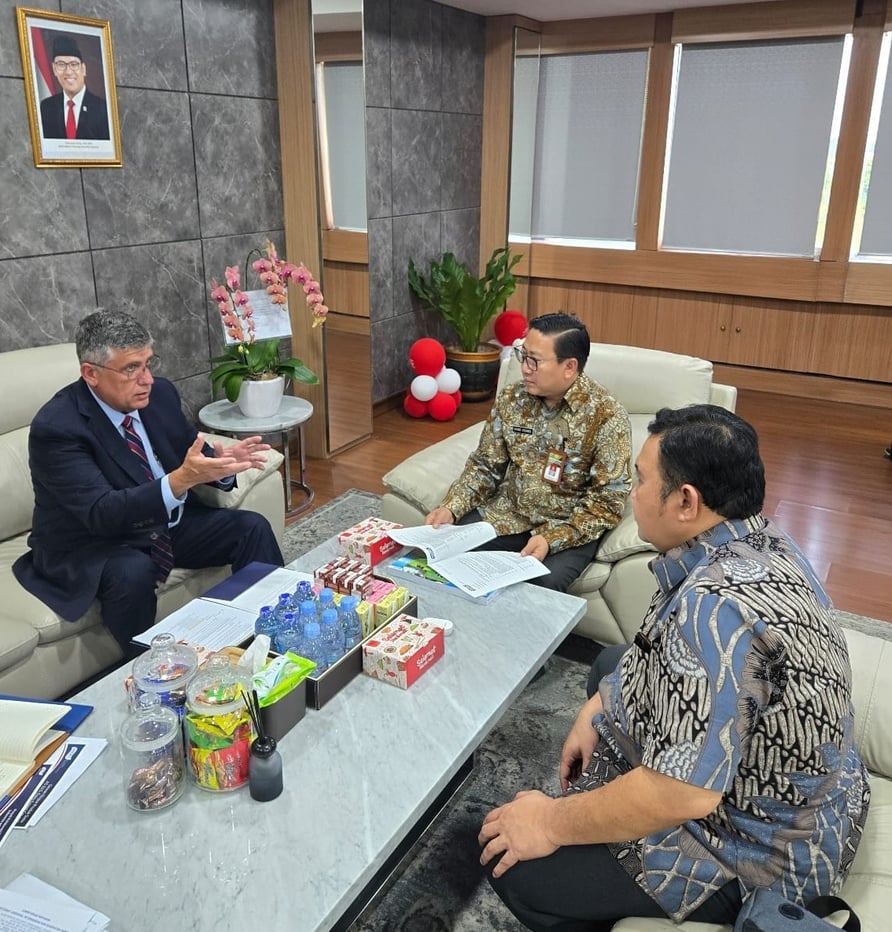
Left to right: Jonathan Gardner updates Dr. drh. Agung Suganda, M.Si, the new director-general of DGLAHS, and Professor Epi Taufik from Bogor Agricultural University on the dairy farm technical program and its current progress.
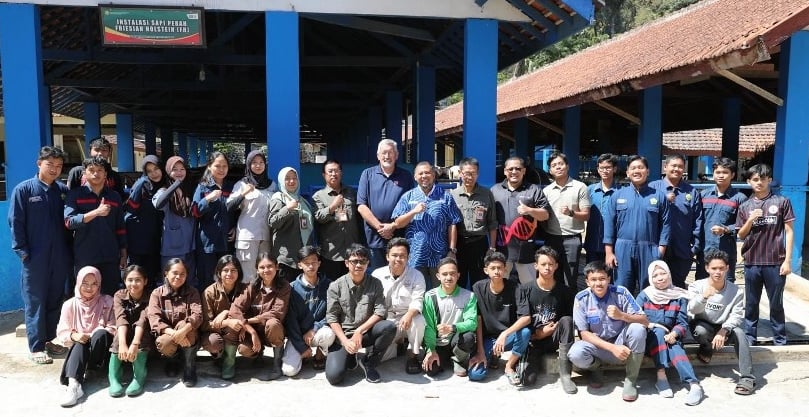
Dr. Robert Hagervoort (back row, center) from NMSU with Dr. Deddy Kurniawan, dairy expert from DairyPro (back row, on Hagervoort’s immediate left), Tresno Wicaksono, USDEC local staff (back row, sixth from right) and workers at a local dairy farm in Malang.
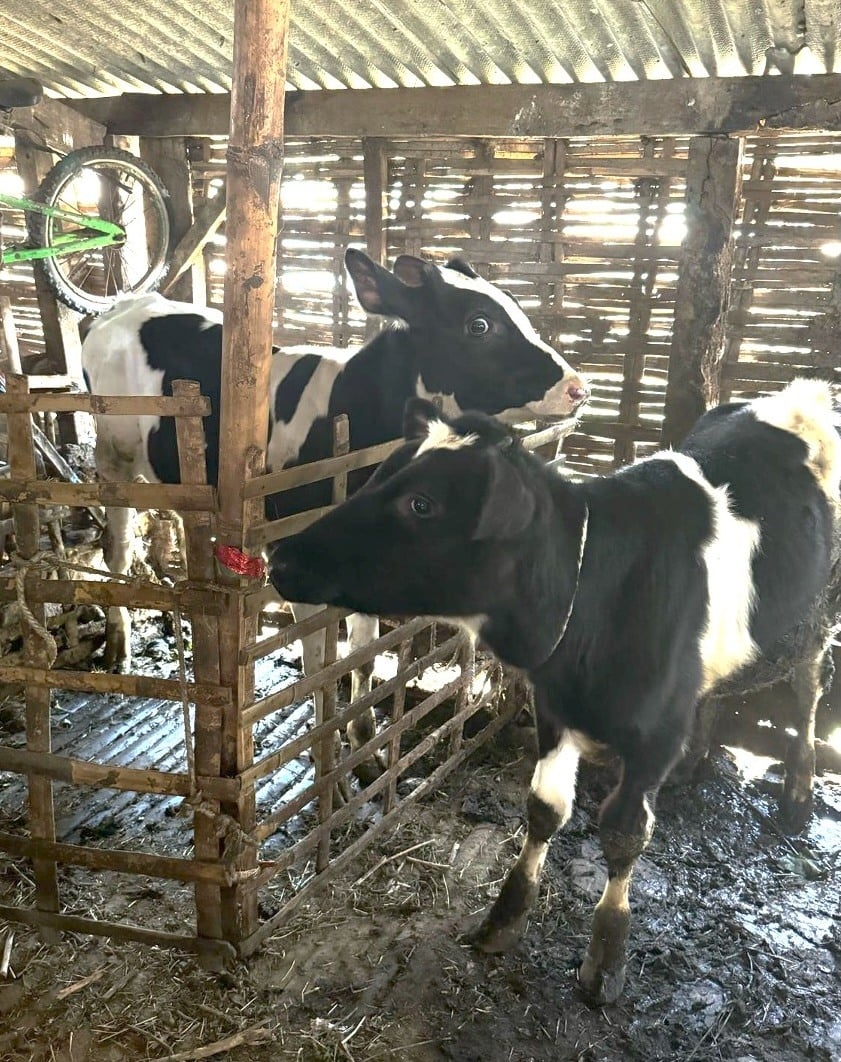
A typical set up and conditions of a backyard dairy farm in Indonesia.
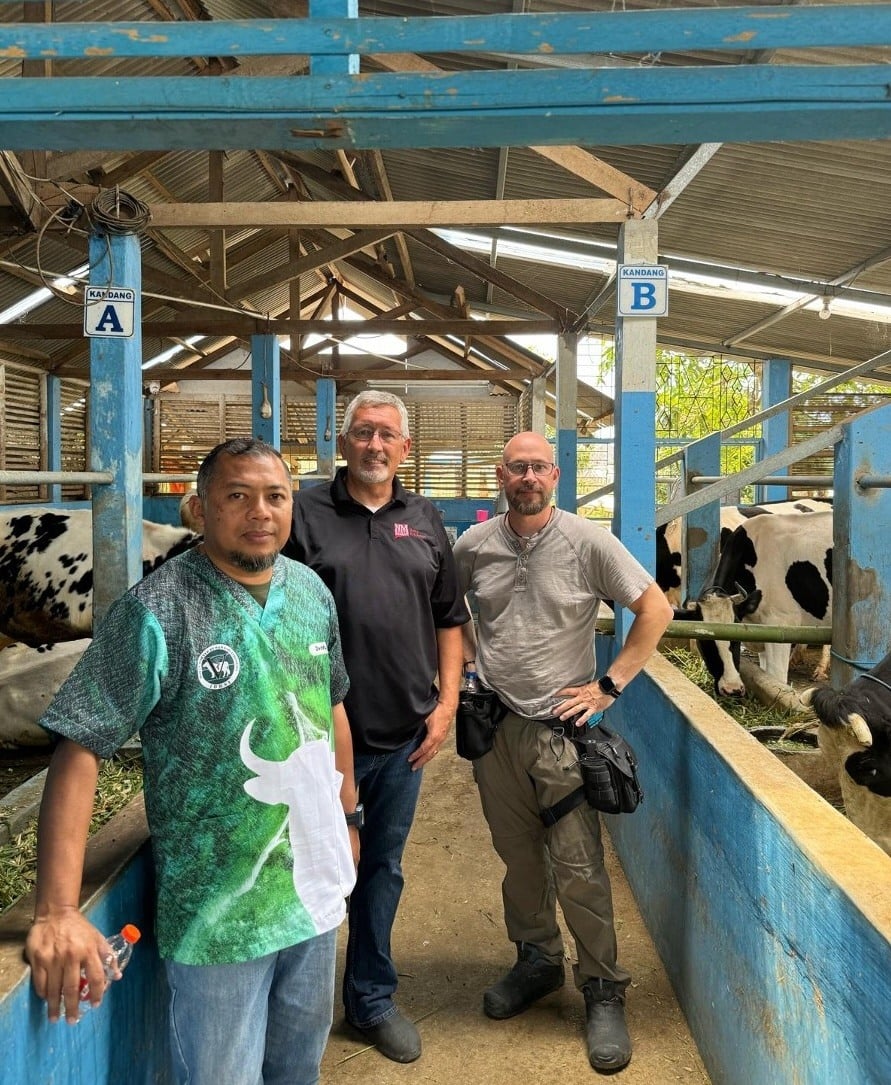
Left to right: Dr. Deddy Kurniawan, dairy expert from DairyPro; Dr. Robert Hagervoort of NMSU; and Brent Peterson of Antigravity Films at a medium scale farm in East Java.
USDEC supports GSP renewal with agricultural provisions
A coalition of 26 agricultural organizations, including USDEC and NMPF, cosigned a letter to the leaders of the Senate Finance and House Ways and Means Committees urging reauthorization of the Generalized System of Preferences (GSP) with several provisions that would facilitate market access for dairy and other U.S. agricultural products.
The GSP program provides developing countries opportunities to export certain products duty-free to the United States. It has been shown to boost investment for the countries in the program, decrease poverty and increase regional stability, among other benefits, ultimately driving demand for food imports, including dairy.
By building goodwill with potential customers, “the GSP program offers a starting point to broaden and deepen trading relationships with countries,” the letter states. “It is also an important leverage tool to encourage countries to eliminate unjustified trade barriers and follow international standards.”
To receive GSP benefits, recipient countries need to abide by certain criteria. The letter makes several recommendations for those criteria, some of which USDEC and NMPF contributed. They include:
- Refraining from imposing prohibitions on common food and beverage terms like “parmesan.”
- Maintaining reasonable and equitable market access to U.S. food and agricultural goods, including dairy.
- Upholding science-based and non-discriminatory sanitary and phytosanitary import requirements for agricultural goods.
- Refraining from excessive domestic agricultural subsidies that decrease U.S. market access.
Upcoming FAO report to support the role of food trade in nourishing the world
Last week, Janice Giddens, USDEC vice president, sustainable nutrition, attended the 76th session of the UN Food and Agriculture Organization (FAO) Committee on Commodity Problems (CCP) held at FAO headquarters in Rome. This was the first time USDEC attended the committee, having secured admittance as a direct result of positive discussions with FAO staff during the April USDEC farmer delegation visit to Italy (see Global Dairy eBrief, 5/3/24).
CCP is FAO’s oldest technical committee, focusing on commodity problems of an international character that affect production, trade, distribution and consumption. CCP is of interest to USDEC because of its oversight of EU-financed work by the FAO Markets and Trade Division (EST) on geographical indications (GIs), as well as flagship FAO reports that can influence national policies. The EST division has also led work examining the role of climate and environmental-related provisions for agricultural trade, and how these provisions might meet both environmental and food security objectives.

Though GIs were not discussed, a major highlight of last week’s CCP meeting was the presentation of preliminary findings from the soon-to-be-released FAO State of Commodity Markets worldwide report. For the first time, the so-called SOCO report will focus on the theme, “Trade and Nutrition: Policy coherence for healthy diets,” and examine how trade affects dietary patterns and nutritional outcomes—a topic of growing significance that could influence both global and national policies. The SOCO report is expected to be released in full on Nov. 29.
Preliminary findings presented from the report appear positive, and USDEC is developing a promotional plan to amplify them with policymakers and other influential stakeholders when it is published in full. USDEC intends to use the findings to highlight the important role U.S. dairy exports can play in increasing the nutrient adequacy and healthfulness of global diets.
Moving forward, USDEC will continue to engage with FAO staff and members of this committee to strengthen relationships and identify additional ways to promote the role of international food trade and U.S. dairy exports in delivering global sustainable food systems and healthy diets.
USDEC addresses Chinese officials at business council roundtable
On Wednesday, USDEC Executive Vice President, Policy Development and Strategy, Jaime Castaneda participated in a U.S.-China Bilateral Agriculture Industry Roundtable in Washington, D.C., organized by the U.S.-China Business Council (USCBC). The roundtable was an opportunity for a dialogue to explore partnerships and additional interaction between China and the U.S. food and agriculture sectors.
Building on past work, USDEC highlighted the June business development trip to China (see Global Dairy eBrief, 6/28/24), the importance of U.S.-China dairy trade and the interest of U.S. suppliers to work together to fill the gaps between Chinese dairy production and demand. Also in the spotlight were the U.S. dairy industry’s ongoing efforts to build relationships with China through engagement with groups like the China Chamber of Commerce of Foodstuffs and Native Produce (CFNA) and partnerships with organizations like Jiangnan University.
Chinese and U.S. companies and organizations spoke at the roundtable with the aim of advancing bilateral trade. U.S. and Chinese officials also spoke, including Lyu Jiang, Minister at the Economic and Commercial Office of the Chinese Embassy, and Craig Allen, USCBC president and former U.S. ambassador to Brunei.
New and Improved: Global Cheese Database refreshed with forecasts through 2026
USDEC’s Strategic Insights team released updated data in the Global Cheese Database and several enhancements, such as:
- Doubling the number of trade interviews conducted in global markets.
- Allocating additional resources to geographical indication cheeses.
- Incorporating in-market visits for deeper insights into trade volumes.
- Including additional USDEC analysis for U.S. cheddar-type varieties.
- Refreshing the design and layout of the interactive dashboard for a more intuitive user experience.
The Strategic Insights team also refined its methodology to enable biannual updates, with the next release scheduled for February 2025.
This members-only tool provides cheese varietal-level data on consumption, production, and trade for 33 countries—both historic and forecast—offering more transparency than HS-code data and filling gaps in trade statistics to help identify export markets and growth opportunities.
USDEC members can access the database dashboard here. To request data for specific markets or varieties or a demo, please email Scott Lantz at slantz@usdec.org.
Danish farm leaders visit USDEC’s Arlington office
A 20-plus-person agricultural delegation from Denmark visited USDEC offices in Arlington, Virginia, last Friday to talk about dairy and ag production and trade. The delegation represented all areas of agriculture, but with strong dairy elements, including a Danish dairy farmer, a member of Arla Foods’ board of directors, and several agricultural policy professionals across products sectors. The meeting presented another opportunity for USDEC to strengthen ties with dairy and agricultural producers in Europe and seek common ground on which both parties could collaborate to the benefit of dairy as a whole.

USDEC President and CEO Krysta Harden with Merete Juhl, CEO, Danish Agriculture and Food Council (left), and Søren Søndergaard, chairman, Danish Agriculture and Food Council.
Events
U.S. cheese featured at Congressional Agricultural Trade Caucus event
USDEC continues to cooperate closely with the bipartisan Congressional Agricultural Trade Caucus, which has served as a valuable ally on major trade policy concerns since it was formed earlier this year. USDEC and NMPF have engaged with the caucus on several issues, including letters to the administration on the need for a more aggressive trade policy and regarding the Colombia CVD investigation.
On Tuesday, USDEC co-sponsored a Congressional Agricultural Trade Caucus reception on Capitol Hill with NMPF, Farmers for Free Trade, Wine Institute, and Western Growers. The event attracted agricultural staff from a number of embassies. Opening remarks by caucus co-chairs—Reps. Jim Costa (D-CA), Dusty Johnson (R-SD), Jimmy Panetta (D-CA) and Adrian Smith (R-NE)—were followed by 1.5 hours of networking over a U.S. cheese table provided by USDEC members. Rep. GT Thompson (R-PA), chair of the House Ag Committee; Rep. John Duarte (R-CA); and Amb. Doug McKalip, chief agricultural negotiator for the USTR also attended and provided remarks.
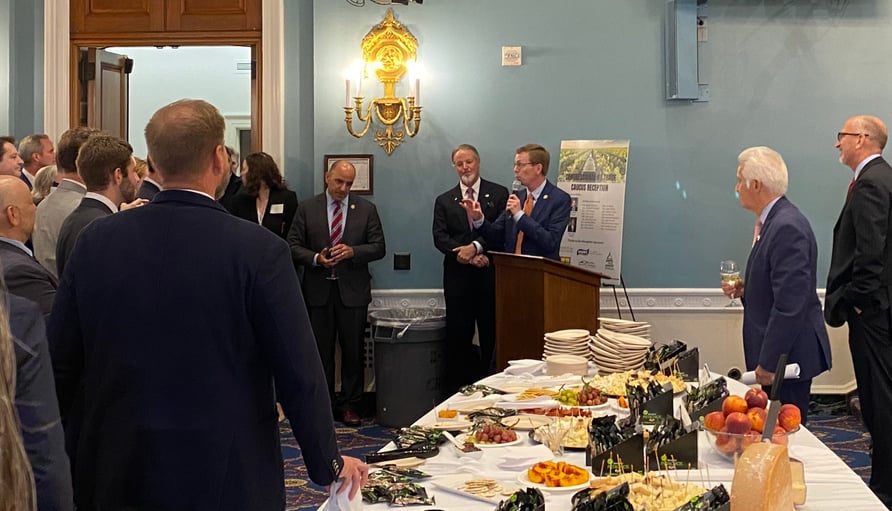
Rep. Dusty Johnson (at podium) offers opening remarks at the Congressional Agricultural Trade Caucus reception on Capitol Hill.
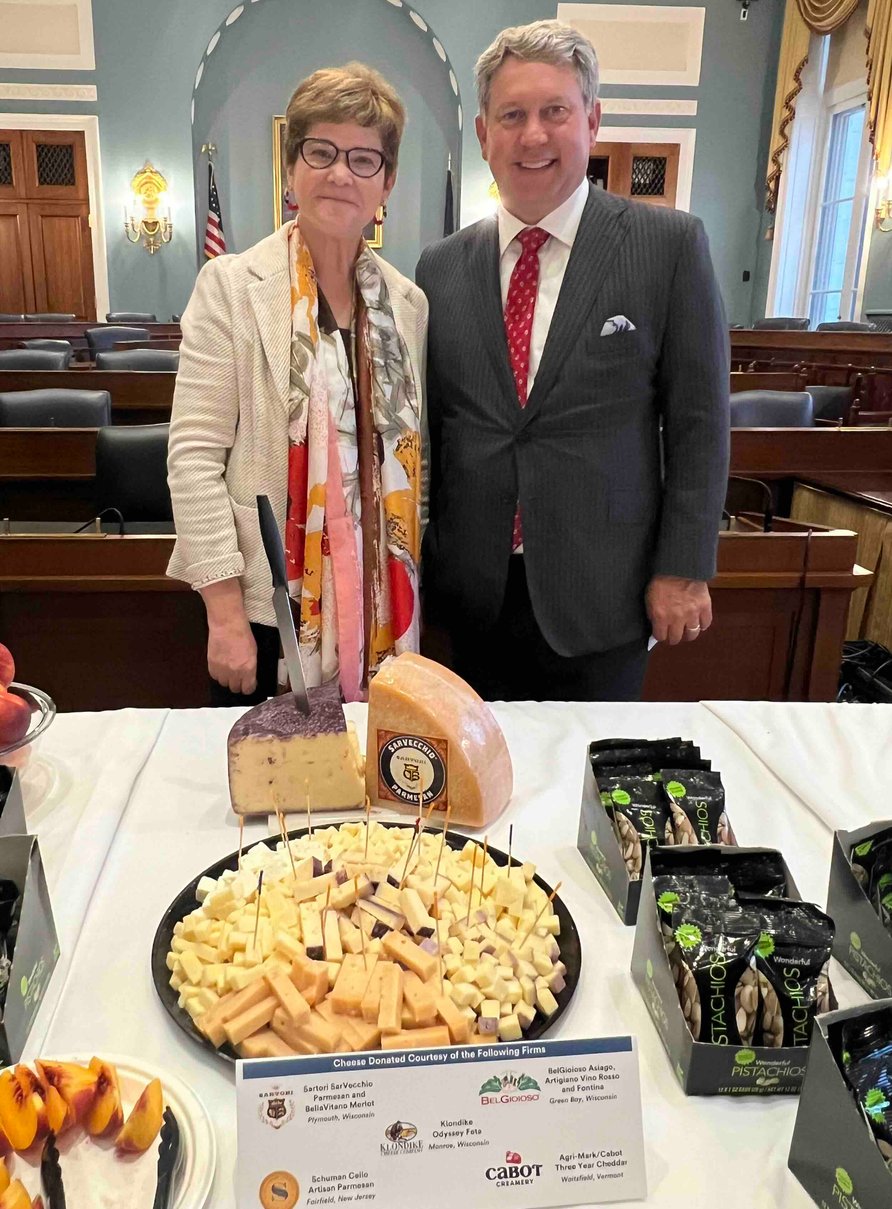
USDEC President and CEO Krysta Harden and NMPF President and CEO Gregg Doud show off a portion of the U.S. cheeses served to attendees at the reception.
Supply Chain
USDEC calls for administration to facilitate resolution in East, Gulf Coast dockworker contract talks
A coalition of more than 175 business groups, including USDEC and NMPF, co-signed a letter to President Biden urging the administration to address the threat of an East and Gulf Coast dockworkers’ strike. The letter reiterates the messaging in a similar coalition letter sent in June (see Global Dairy eBrief, 6/28/24), the biggest difference being that a potential strike is now less than two weeks away.
The International Longshoremen’s Association (ILA) has repeatedly threatened a coastwide strike if a new contract is not negotiated with the United States Maritime Alliance (USMX) by Oct. 1. The existing contract expires on Sept. 30.
“We call upon the administration to immediately work with both parties to resume contract negotiations and ensure there is no disruption to port operations and cargo fluidity if a new contract is not reached by the expiration date,” the letter states.
The coalition commended the administration on previous action to avert supply chain disruptions but warned that a strike at this time would “have a devastating impact on the economy, especially as inflation is on a downward trend.”
Alternatives being considered as U.S. East Coast strike looms
With no agreement in sight in contract talks between the ILA and USMX, shipping analysts reportedly say a strike at U.S. East Coast and Gulf Coast ports looks increasingly likely. Officials on both sides have been reluctant to comment, and it’s unclear when the two sides last met for a formal bargaining session. USMX said there’s still time for a new master contract but that it needs the ILA to return to the table.
Reuters reports that President Biden does not intend to invoke a federal law to prevent a port strike. “We encourage all parties to remain at the bargaining table and negotiate in good faith,” a Biden Administration official reportedly told the media outlet.
In light of the apparent stalemate (compensation and automation are said to be the biggest sticking points), some shippers are looking for alternatives and backup plans.
Industry analysts say they anticipate a significant increase in traffic through Canadian ports, including Halifax and Montreal, but bottlenecks may emerge as freight transitions to rail carriers in North America. An official at the Port of Long Beach said it is equipped and ready to handle increased capacity prompted by cargo diversions in the event of a strike and that the San Pedro Bay port complex is in a “good” position to meet shipper expectations. (The Loadstar, 9/17/24; Freight Waves, 9/16/24; Supply Chain Dive, 9/16/24)
Market Summary
GDT rises 0.8%
The Global Dairy Trade (GDT) Price Index increased 0.8% at the Sept. 17 auction. While most products posted gains, the results felt disappointing in light of very strong recent dairy commodity price movements in Europe and the United States.
Demand was mixed. North Asia (China) was the top buyer for the fourth straight auction, leading all purchasers in WMP, SMP and butter. It bought more SMP than the previous auction (and the same auction the previous year), but its WMP and butter appetite fell short of the Sept. 3 event. The Middle East bounced back this week, buying 13% of volume sold after retreating to only 9% on Sept. 3, but Southeast Asia/Oceania demand slumped, with the region taking only a 22% share after a strong 30% showing on Sept. 3.
Expectations for a strong New Zealand 2024/25 milk production season may also be a factor limiting GDT price hikes at the moment. (At press time, after the auction, New Zealand reported August milk output jumped 9% in tonnage and 10% in milk solids terms.)
Results by product
Butterfat was the biggest drag on the GDT Price Index at this week’s auction (even though GDT butterfat prices are still well elevated compared to historical averages). While EU butter prices continue to boom, New Zealand prices have held in a range of US$6,400-$6,700/MT for most of the year (except for a short-lived May/June spike). That remained the case on Sept. 17. This week, the average winning GDT butter price fell 1.7% to US$6,546/MT.
AMF declined for the first time in five auctions, falling 1.2% to US$7,220/MT. But it still remains in shouting distance of the record high of US$7,417/MT set at the June 4 event.
Cheese and milk powder prices moved in the opposite direction to butterfat. The average winning cheddar price rose 2.9% to US$4,441/MT—the highest price since this February. Mozzarella set its fourth straight record high, jumping 4.5% to US$5,351/MT.
WMP and SMP prices largely followed SGX-NZX expectations heading into the auction. Strong demand from China helped lift SMP 2.2% to US$2,809/MT. It marks the first time SMP prices have topped US$2,800/MT since February 2023. WMP increased 1.5% to US$3,448/MT.
EU milk delivery growth weakens in July
With all but two countries reporting, year-over-year (YOY) EU27+UK milk production was on track to decline 0.3% in July—a big shift from the 0.8% average monthly increase from March-June. No. 1 producer Germany is one of the countries yet to report, so the July estimate could change significantly. But Germany’s YOY deliveries in June were flat and anecdotal reports of weekly German milk output in July suggest it is unlikely to reverse that July decline. If Germany does not deliver, it would be the first YOY decline in EU27+UK milk since January.
While Poland, Italy and France managed YOY gains of 1.2-1.5% in July, Ireland and the Netherlands saw production fall 3.3% and 3.1%, respectively. UK output was flat.
Bluetongue virus is still on the upswing in Europe and remains a significant challenge in much of the EU27+UK. The virus had spread to at least eight countries at press time, with Sweden and Austria the latest to report their first cases.
A new variant of the virus, which was first reported in late 2023 in the Netherlands, is proving more difficult to bring under control. Pharmaceutical firms are tweaking vaccines, but farmers so far are reporting only limited success, reportedly dampening symptoms but not stopping the spread of the disease. Cases are expected to continue to rise until cooler temperatures arrive and make the mites who spread the virus less active. (Reuters, 9/16/24; Farmers Guardian, 9/12/24; Science, 8/20/24)
USDEC News
Changes to USDEC board elections
The switch to a once-a-year USDEC annual meeting has impacted the timing of annual board elections. Historically, all officer positions were voted on by membership at the fall meeting (USDEC’s bylaws require an in-person board vote for these positions). Because of the elimination of the fall meeting, the next leadership elections will take place at the Spring 2025 meeting. This means the current chair, vice chair, treasurer and two of the four at-large Operating Committee positions will (for this one time) have a six-month longer term than in the past. Future elections will recur at each spring meeting annually moving forward. USDEC sent an email to board members last week announcing the change. If you have any questions, please contact Luke Waring at lwaring@usdec.org. Thank you!
Company News
Valio investing €70m In Seinäjoki production plant
To increase capacity and improve operational and energy efficiency in its production plant in Seinäjoki, Finland-based Valio is investing €70 million (about US$78 million) in modernization efforts. Valio, which exports more than 80% of its milk powders, provides specialty milk powders primarily for international industrial customers for use in products like confections, baked goods and baby food. In addition to the construction of a new regional laboratory facility at the site, the company said enhancements will include a new washing center for the powder plant, modernization of the powder plant’s drying tower and a process overhaul. The renovation of the drying process at the plant will create additional production capacity for specialty milk powder production in Seinäjoki and improve energy efficiency in the powder production process. The improvements are expected to be complete in 2026. (Company reports)
Lactalis to invest €16 million+ in Brazil factories
French dairy giant Lactalis said it will invest €16.5 million (about US$18.4 million) to expand its operations in Rio Grande do Sul, the southernmost state of Brazil. The investment, which will provide improvements to five factories throughout 2025, will include new production lines (a processed cheese line in Santa Rosa, a whey protein line in Teutônia, and a mozzarella line in Três de Maio) and increasing the capacity for energy generation in Ijuí to support cheese production. (Dairy Global, 9/11/24)
FoodWaikato invests in colostrum expansion
New Zealand’s FoodWaikato (owned by New Image Group) is spending NZ$7 million (about US$4.3 million) to upgrade its Ruakura, North Island, spray dryer. The project is part of an effort to expand colostrum collection and processing capabilities. The company is also spending NZ$4.5 million (about US$2.8 million) on R&D aimed at upgrading its nutritional claims. New Image exports its product to 26 countries, turning colostrum into a powdered drink for both adults and children to promote gut health. (Farmers Weekly, 9/18/24)
Mergers, acquisitions and joint ventures
Nestlé said it will sell its Cremora business in South Africa to France-based dairy giant Lactalis. As part of the deal, Lactalis will acquire two of Nestlé’s South African plants that currently manufacture the creamer brand. Nestlé’s third plant that produces Cremora will stop manufacturing the brand once the transaction is complete. … On the heels of its recent acquisition of UK food delivery business Müller’s Milk & More, UK dairy company Freshways Group acquired Wales-based Totally Welsh Dairy. A Freshways official said the deal will allow the company to “better serve our customers with an expanded range of products while supporting local Welsh farmers.” (FoodBev Media, 9/13/24; Just Food, 9/13/24)
Company Briefs
Switzerland-based Nestlé committed to building its first food manufacturing plant in Saudi Arabia, with the signing of an agreement with the Saudi Authority for Industrial Cities and Technology Zones (Modon) for a 1.3-million-sq.-ft. plot in Jeddah's Third Industrial City. Nestlé did not specify exactly what the facility would make, other than saying it would manufacture “children’s food.” The plant will produce for both the Saudi market and also export markets in the Middle East and North Africa. … Missouri-based Hiland Dairy Foods announced the expansion of its Tyler, Texas, operations with the addition of 90,000 square feet to its existing facility. The expansion, which is expected to be complete in early 2026, will include state-of-the-art processing, filling, casing, palletizing, load-out, and storage areas, as well as a new lab. … New Zealand dairy co-op Fonterra said it will invest around NZ$150 million (about US$167 million) for a new cool store at its Whareroa site in Taranaki. The building will store about 26,000 MT of cheese. Construction is slated to begin in October and take about three years to complete. … Nigerian dignitaries joined Danone officials at the launch of a new Fan Milk yogurt production line in Ibadan, Oyo State. Government officials said the new production line will improve the quality and availability of dairy products for the local population, while generating employment, invigorating local economies and contributing to Nigeria’s GDP. … In response to evolving consumer preferences and growing demand in the Nigerian market, CWAY Foods and Beverages unveiled three new drink products: Café Coffee Milk, Fuji Probiotic, and Assam Milk Tea. At the triple product launch, Cway executives explained how the company’s distribution strategy will make these products accessible to Nigerians in both urban and remote areas through its advanced supply chain management system and partnerships with key distributors. (USDEC Middle East/North Africa office; Company reports; The Sun, 9/17/24; Brand Communicator, 9/17/24)
In Case You Missed It...
U.S. Dairy Exporter Blog
Market analysis, research and news subscribe hereUSDEC Twitter feed
Follow us here.